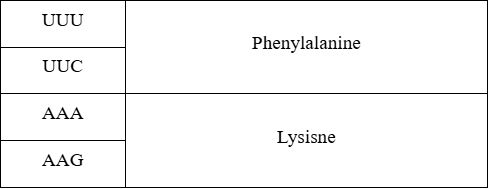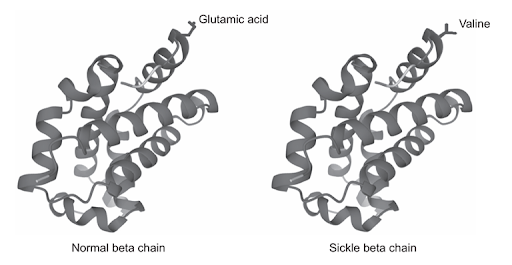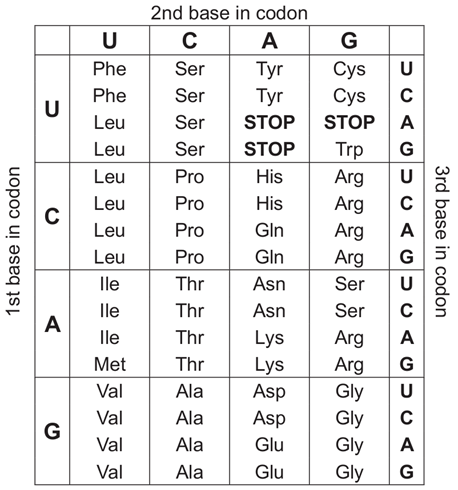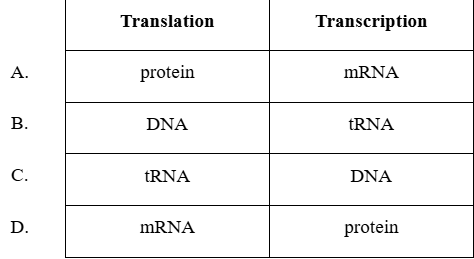Question 1
The data shows part of the genetic code for mRNA. Which anticodon could be found on a tRNA molecule bonded to lysine? [1]

A. AAG
B. UUC
C. TTT
D. GAA
Medium
Mark as Complete
Mark Scheme
Question 2
The diagram shows the translation of a mRNA molecule.

A tRNA molecule with anticodon CAG carries the amino acid phenylalanine. Which codon of mRNA will the tRNA join? [1]
A. CTG
B. CAG
C. GTC
D. GUC
Easy
Mark as Complete
Mark Scheme
Question 3
What is formed during transcription? [1]
A. RNA strand complementary to DNA strand, formed by RNA polymerase
B. DNA strand complementary to DNA strand, formed by DNA polymerase
C. RNA strand complementary to RNA strand, formed by DNA polymerase
D. DNA strand complementary to RNA strand, formed by RNA polymerase
Easy
Mark as Complete
Mark Scheme
Question 4
Hemoglobin is a protein made up of two alpha and two beta polypeptide chains. In sickle cell anemia, a mutation causes one glutamic acid in each beta chain to be replaced by valine, as shown in the image.

How does this mutation in hemoglobin cause sickle cell anemia? [1]
A. It prevents the beta chains from forming a protein.
B. It replaces an amino acid with a fatty acid in the beta chain.
C. It changes the three-dimensional conformation of hemoglobin.
D. The polypeptide produced in sickle hemoglobin is shorter than in normal hemoglobin.
Medium
Mark as Complete
Mark Scheme
Question 5
The table shows the genetic code.

Which mRNA could code for the sequence Ser-Leu-Arg-Phe? [1]
A. UCA UCG UGG UUU
B. UCC ACC AGA UUC
C. UCU CCC AGA UUU
D. UCG CUG AGG UUC
Medium
Mark as Complete
Mark Scheme
Question 6
Which molecules are formed as a direct result of translation and transcription? [1]

Easy
Mark as Complete
Mark Scheme
Question 7
What happens to mRNA after transcription in eukaryotic cells? [1]
A. Binding to the large subunit of the ribosome
B. Removal of introns
C. Addition of exons
D. Attachment of an amino acid
Easy
Mark as Complete
Mark Scheme
Question 8
Which diagram shows modified mRNA after transcription? [1]

Medium
Mark as Complete
Mark Scheme
Question 9
(a)Outline the structure of proteins.
(b)Cells produce a large variety of proteins with different sequences of amino acids. Explain how this is done. [10]
Hard
Mark as Complete
Mark Scheme
Question 10
Describe the genetic code and its relationship to polypeptides and proteins. [5]
Hard
Mark as Complete
Mark Scheme
Question 1
The data shows part of the genetic code for mRNA. Which anticodon could be found on a tRNA molecule bonded to lysine? [1]

A. AAG
B. UUC
C. TTT
D. GAA
Answer: B
A. Incorrect: If the mRNA codon is AAG, the anticodon cannot be AAG. The anticodon must pair complementarily (A-U, G-C). So, AAG is incorrect, because it is the same as the mRNA codon, not the complementary one.
B. Correct: The anticodon pairs with the mRNA codon AAA (for lysine). The complementary bases of AAA are UUU, but since mRNA may also have AAG, the complementary anticodon could be UUC. Therefore, UUC is the anticodon found on tRNA carrying lysine.
C. Incorrect: This is incorrect because anticodons are part of tRNA, which contains RNA, not DNA. RNA uses uracil (U) instead of thymine (T). So TTT is a DNA triplet, not an RNA anticodon.
D. Incorrect: This is also incorrect because GAA is the complement of CUU, not AAA or AAG. It would pair with an mRNA codon for leucine, not lysine.
Question 2
The diagram shows the translation of a mRNA molecule.

A tRNA molecule with anticodon CAG carries the amino acid phenylalanine. Which codon of mRNA will the tRNA join? [1]
A. CTG
B. CAG
C. GTC
D. GUC
Answer: D
A. Incorrect: This option contains T (thymine) - but mRNA never has thymine, it uses U (uracil). Also, C-G and T-A pairing would match DNA, not RNA.
B. Incorrect: This is identical to the anticodon on the tRNA. Codon and anticodon must be complementary, not the same. So, CAG would pair with GUC, not itself.
C. Incorrect: It contains T (thymine) instead of U (uracil) like option A. This represents a DNA triplet rather than an mRNA codon. While GTC could be the DNA coding sequence that corresponds to GUC in mRNA, it is not the codon actually read by the ribosome during translation. Therefore, GTC is incorrect.
D. Correct: It follows the complementary base-pairing rule with the anticodon CAG. Cytosine (C) pairs with guanine (G), adenine (A) pairs with uracil (U), and guanine (G) pairs with cytosine (C), forming a perfect match. Thus, the tRNA with anticodon CAG binds to the mRNA codon GUC during translation to add the amino acid phenylalanine to the growing polypeptide chain.
Question 3
What is formed during transcription? [1]
A. RNA strand complementary to DNA strand, formed by RNA polymerase
B. DNA strand complementary to DNA strand, formed by DNA polymerase
C. RNA strand complementary to RNA strand, formed by DNA polymerase
D. DNA strand complementary to RNA strand, formed by RNA polymerase
Answer: A
A. Correct: During transcription, an enzyme called RNA polymerase reads one strand of the DNA (the template strand) and synthesizes a complementary RNA strand. The bases pair according to the rule A-U and G-C. This RNA strand carries the genetic information needed for protein synthesis.
B. Incorrect: This describes DNA replication, not transcription. In replication, DNA polymerase makes a new DNA strand complementary to the original DNA strand.
C. Incorrect: DNA polymerase acts only on DNA, not RNA. Also, transcription does not use an RNA template-it uses DNA.
D. Incorrect: RNA polymerase synthesizes RNA, not DNA. Therefore, this option describes the wrong type of molecule and enzyme.
Question 4
Hemoglobin is a protein made up of two alpha and two beta polypeptide chains. In sickle cell anemia, a mutation causes one glutamic acid in each beta chain to be replaced by valine, as shown in the image.

How does this mutation in hemoglobin cause sickle cell anemia? [1]
A. It prevents the beta chains from forming a protein.
B. It replaces an amino acid with a fatty acid in the beta chain.
C. It changes the three-dimensional conformation of hemoglobin.
D. The polypeptide produced in sickle hemoglobin is shorter than in normal hemoglobin.
Answer: C
A. Incorrect: The mutation does not stop the beta chains from being produced. The beta chains are still made, but their shape changes due to the amino acid substitution.
B. Incorrect: The mutation changes one amino acid (glutamic acid) to another amino acid (valine), not to a fatty acid. Both are amino acids, but they differ in polarity and charge.
C. Correct: In sickle cell anemia, a point mutation occurs in the gene coding for the β chain of hemoglobin, where the DNA base A is replaced by T. This causes one amino acid, glutamic acid (hydrophilic), to be replaced with valine (hydrophobic). Because valine repels water, it creates a hydrophobic spot on the hemoglobin molecule. This change alters how the hemoglobin folds, causing molecules to stick together and form long fibers in low oxygen conditions. As a result, red blood cells become distorted into sickle shapes, losing their normal flexibility and reducing oxygen transport. Thus, the mutation leads to a change in the protein’s 3D structure, which is the direct cause of sickle cell anemia symptoms.
D. Incorrect: The mutation changes only one amino acid; it does not add or delete codons. Therefore, the polypeptide chain remains the same length.
Question 5
The table shows the genetic code.

Which mRNA could code for the sequence Ser-Leu-Arg-Phe? [1]
A. UCA UCG UGG UUU
B. UCC ACC AGA UUC
C. UCU CCC AGA UUU
D. UCG CUG AGG UUC
Answer: D
A. Incorrect: UCA codes for serine (Ser), which is correct for the first amino acid. However, UCG also codes for serine, not leucine (Leu), so the second codon is wrong. UGG codes for tryptophan (Trp), not arginine (Arg), and UUU codes for phenylalanine (Phe), which is correct for the last amino acid. Because the second and third codons are incorrect, this option is wrong.
B. Incorrect: UCC codes for serine (Ser) - correct first amino acid. However, ACC codes for threonine (Thr), not leucine (Leu). AGA codes for arginine (Arg) - correct third amino acid, and UUC codes for phenylalanine (Phe) - correct last amino acid. The second codon is wrong, so this sequence does not match fully.
C. Incorrect: UCU codes for serine (Ser) - correct first amino acid. CCC codes for proline (Pro), not leucine (Leu), so the second amino acid is incorrect. AGA and UUU correctly code for arginine (Arg) and phenylalanine (Phe), but because the second codon is wrong, this option is incorrect overall.
D. Correct: UCG codes for serine (Ser), CUG codes for leucine (Leu), AGG codes for arginine (Arg), and UUC codes for phenylalanine (Phe). All four codons perfectly match the sequence Ser-Leu-Arg-Phe, so this is the correct answer.
Question 6
Which molecules are formed as a direct result of translation and transcription? [1]

Answer: A
A. Correct: During transcription, a strand of mRNA is produced using DNA as a template. The enzyme RNA polymerase joins complementary RNA nucleotides to form mRNA, which carries the genetic code to the ribosome. During translation, the mRNA sequence is read by ribosomes, and proteins (polypeptides) are synthesized by joining amino acids according to the codons on the mRNA. Thus, mRNA is the product of transcription, and protein is the product of translation.
B. Incorrect: DNA is not produced by translation; translation makes proteins. Also, tRNA is not formed by transcription in the way mRNA is. While tRNA molecules are transcribed from specific genes, the question asks for the direct result of transcription in the general process of gene expression - which is mRNA, not tRNA.
C. Incorrect: Translation does not produce tRNA; instead, tRNA helps in translation by bringing amino acids to the ribosome. DNA is also not produced by transcription; transcription uses DNA as a template to make RNA. Therefore, both parts of this option are incorrect.
D. Incorrect: This reverses the actual processes. mRNA is made in transcription, not translation, and proteins are made in translation, not transcription. The sequence of gene expression is DNA 🡪 mRNA 🡪 protein, so this option is incorrect.
Question 7
What happens to mRNA after transcription in eukaryotic cells? [1]
A. Binding to the large subunit of the ribosome
B. Removal of introns
C. Addition of exons
D. Attachment of an amino acid
Answer: B
A. Incorrect: This step occurs after mRNA processing, during translation, not immediately after transcription. Before mRNA can bind to ribosomes, it must first be processed (splicing, capping, and tailing) and transported out of the nucleus. Therefore, this is not the first thing that happens after transcription.
B. Correct: After transcription, the newly made pre-mRNA in eukaryotic cells contains both exons (coding sequences) and introns (non-coding sequences). The introns are removed by a process called RNA splicing, which is carried out by the spliceosome complex. This processing step produces mature mRNA, which can then leave the nucleus to be translated into protein.
C. Incorrect: Exons are not added; they are the parts of the gene that remain after introns are removed. The exons are joined together to form the final continuous coding sequence, but no new exons are created or added.
D. Incorrect: Amino acids attach to tRNA molecules, not mRNA. This step happens during translation, when tRNA molecules bring amino acids to the ribosome according to the codons on the mRNA.
Question 8
Which diagram shows modified mRNA after transcription? [1]

Answer: A
A. Correct: After transcription, the pre-mRNA undergoes three main modifications: addition of a 5′ cap (G-cap) - protects mRNA from degradation and helps ribosome binding; splicing - introns are removed, and exons are joined together to form a continuous coding sequence; addition of a poly-A tail (AAAAA) at the 3′ end - stabilizes the mRNA and aids export from the nucleus. Therefore, this diagram (diagram A) shows only exons, has a 5′ G-cap, and a 3′ poly-A tail, matching the structure of mature mRNA.
B. Incorrect: This structure in the diagram (diagram B) still contains introns, which are removed during RNA splicing. It also has UUUUU at the end instead of the poly-A tail, which is incorrect. Represents unprocessed pre-mRNA, not modified mRNA.
C. Incorrect: This diagram shows only introns, which are non-coding and removed before forming mature mRNA. Even though it has a G-cap and poly-A tail, the sequence would not code for any protein because exons are missing. So, incorrect representation of modified mRNA.
D. Incorrect: This strand still includes introns, which should have been spliced out during mRNA processing. It also ends with UUUUU instead of a poly-A tail, so it’s not a mature mRNA molecule. Therefore, represents partially processed or unprocessed RNA, not fully modified mRNA.
Question 9
(a)Outline the structure of proteins.
(b)Cells produce a large variety of proteins with different sequences of amino acids. Explain how this is done. [10]
(a) Any three of the following:
a. protein formed from amino acids or 20 different amino acids;
b. linked together by peptide bonds;
c. may consist of one or more polypeptides linked together;
d. have a specific shape/conformation/folding;
e. shape determines function;
Sample answer:
Proteins are made up of amino acids about 20 different kinds which linked together by peptide bonds to form polypeptide chains [2];
A protein may consist of one or more polypeptides linked together [1];
Each protein has a specific three-dimensional shape (conformation) determined by how the chain folds, and this shape determines its function [2].
(b) Any seven of the following:
a. protein is produced when a gene is expressed/switched on;
b. genetic code/codons consists of three nucleotides/bases/base triplet;
c. genetic code in DNA is transcribed/transcription (to mRNA);
d. mRNA exits the nucleus;
e. mRNA (code) is translated/translation into a polypeptide/protein;
f. amino acid sequence/polypeptide formation occurs at a ribosome;
g. one codon translates to one amino acid;
h. tRNA carries code for specific amino acids;
i. tRNA anticodon matches with specific codon in mRNA;
j. amino acids joined (by peptide bonds) to form polypeptide;
k. sequence of amino acids determined by order of bases/nucleotides/codons in
DNA/mRNA;
l. proteins vary based on which amino acids are used and their order or protein variety increases by mutations to DNA;
Sample answer:
Cells produce a large variety of proteins with different sequences of amino acids because each protein is encoded by a specific gene, and only certain genes are expressed at a given time. When a gene is switched on [1], its DNA sequence is transcribed into messenger RNA (mRNA) [1], which carries the genetic code from the nucleus to the ribosome. The genetic code consists of codons, each made of three bases, and each codon specifies a particular amino acid [1]. During translation, transfer RNA (tRNA) molecules, each carrying a specific amino acid, pair their anticodons with matching codons on the mRNA [2]. As the ribosome moves along the mRNA, the amino acids are joined together by peptide bonds to form a polypeptide chain [2]. The sequence of amino acids is therefore determined by the sequence of bases in the gene [1], and variations in DNA sequences (including mutations) result in different proteins being produced, giving rise to the wide diversity of proteins found in cells [1].
Question 10
Describe the genetic code and its relationship to polypeptides and proteins. [5]
Any five of the following:
a. (the genetic code is based on) sets of three nucleotides/triplets of bases called codons;
b. bases include adenine, guanine, cytosine and thymine in DNA/adenine, guanine, cytosine and uracil in RNA; (do not accept ATCG)
c. each codon is code for one amino acid;
d. some codons are (start or) stop codons;
e. DNA is transcribed into mRNA by base-pair matching/complementary base pairing;
f. mRNA is translated into a sequence of amino acids/polypeptide;
g. each gene codes for a polypeptide;
h. polypeptides may be joined/modified to form proteins;
Sample answer:
The genetic code is made up of sets of three nucleotides, known as codons, each of which codes for a specific amino acid [2]. In DNA, the bases are adenine (A), guanine (G), cytosine (C), and thymine (T), while in RNA, uracil (U) replaces thymine [1]. During transcription, the DNA sequence of a gene is copied into mRNA through complementary base pairing [1]. The mRNA codons are then translated at the ribosome into a specific sequence of amino acids, forming a polypeptide chain [1]. Some codons serve as start or stop signals to control where translation begins and ends [1]. Each gene codes for one polypeptide, and these polypeptides can be modified or combined to produce functional proteins with specific structures and roles in the cell [2].
Question 1
The data shows part of the genetic code for mRNA. Which anticodon could be found on a tRNA molecule bonded to lysine? [1]

A. AAG
B. UUC
C. TTT
D. GAA
Question 2
The diagram shows the translation of a mRNA molecule.

A tRNA molecule with anticodon CAG carries the amino acid phenylalanine. Which codon of mRNA will the tRNA join? [1]
A. CTG
B. CAG
C. GTC
D. GUC
Question 3
What is formed during transcription? [1]
A. RNA strand complementary to DNA strand, formed by RNA polymerase
B. DNA strand complementary to DNA strand, formed by DNA polymerase
C. RNA strand complementary to RNA strand, formed by DNA polymerase
D. DNA strand complementary to RNA strand, formed by RNA polymerase
Question 4
Hemoglobin is a protein made up of two alpha and two beta polypeptide chains. In sickle cell anemia, a mutation causes one glutamic acid in each beta chain to be replaced by valine, as shown in the image.

How does this mutation in hemoglobin cause sickle cell anemia? [1]
A. It prevents the beta chains from forming a protein.
B. It replaces an amino acid with a fatty acid in the beta chain.
C. It changes the three-dimensional conformation of hemoglobin.
D. The polypeptide produced in sickle hemoglobin is shorter than in normal hemoglobin.
Question 5
The table shows the genetic code.

Which mRNA could code for the sequence Ser-Leu-Arg-Phe? [1]
A. UCA UCG UGG UUU
B. UCC ACC AGA UUC
C. UCU CCC AGA UUU
D. UCG CUG AGG UUC
Question 6
Which molecules are formed as a direct result of translation and transcription? [1]

Question 7
What happens to mRNA after transcription in eukaryotic cells? [1]
A. Binding to the large subunit of the ribosome
B. Removal of introns
C. Addition of exons
D. Attachment of an amino acid
Question 8
Which diagram shows modified mRNA after transcription? [1]

Question 9
(a)Outline the structure of proteins.
(b)Cells produce a large variety of proteins with different sequences of amino acids. Explain how this is done. [10]
Question 10
Describe the genetic code and its relationship to polypeptides and proteins. [5]